Wildflowers of the Adirondacks:
Clintonia (Clintonia borealis)
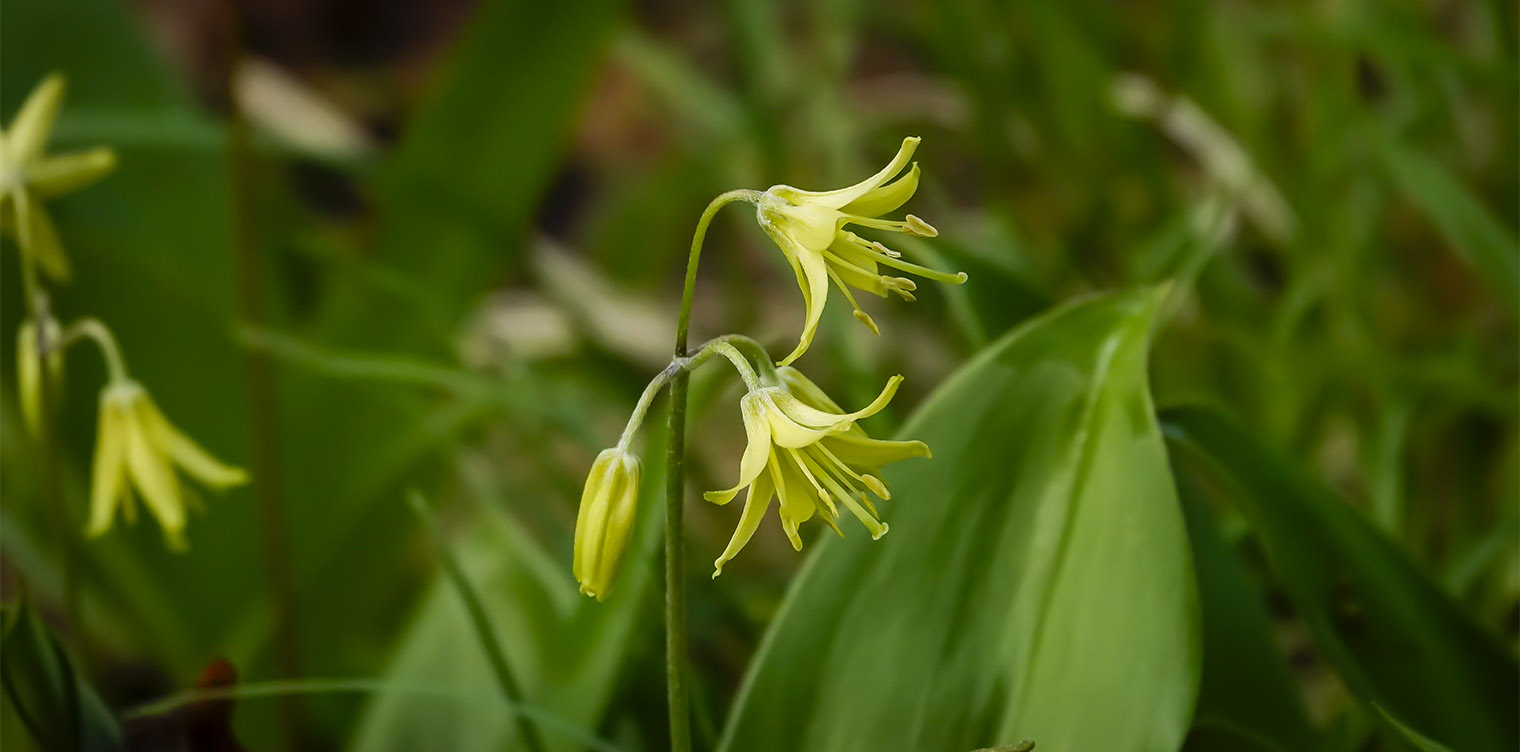
Clintonia (Clintonia borealis), also known as Blue Bead Lily, is a native wildflower that flourishes in a wide variety of habitats in the Adirondacks of upstate New York. It produces small yellow flowers in late spring and porcelain blue berries in mid-summer. It is a member of the Lily Family.
The plant was named in honor of the former governor of New York, DeWitt Clinton (1769-1828). Another name often used for the plant – Blue Bead Lily – is a reference to the blue berries which appear in summer. Other nonscientific names for the plant include Blue Bead Lily, Bluebead Lily, Bluebead-lily, Blue Bead-lily, Clinton's Lily, Clinton Lily, Yellow Clintonia, Yellow Beadlily, Wood Lily, Corn Lily, and Straw Lily.
Identification of Clintonia
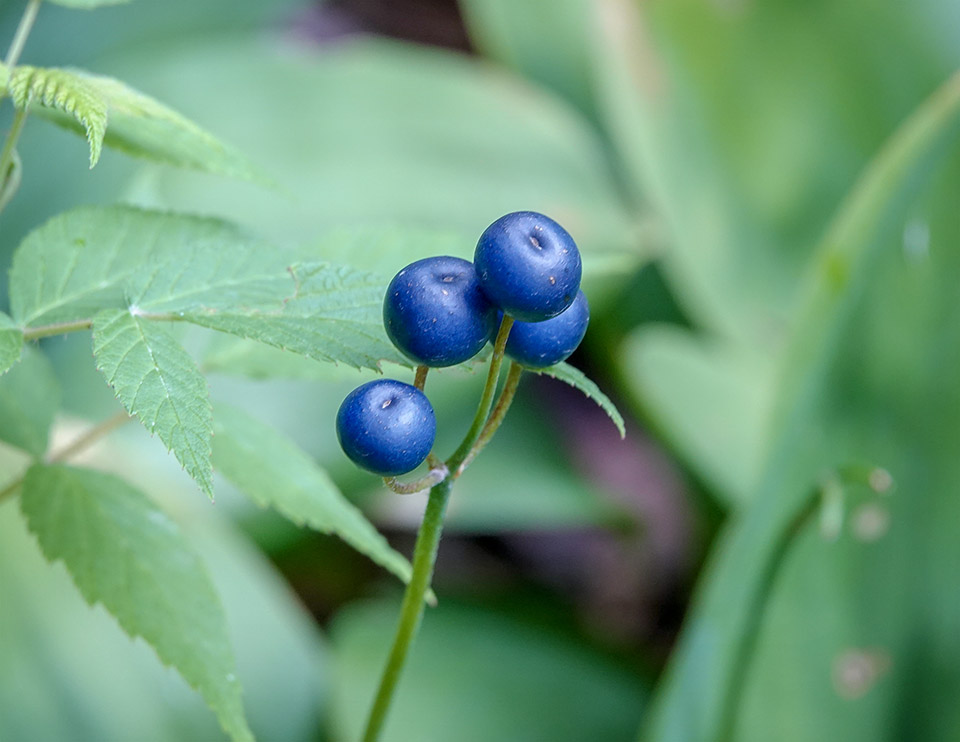
Clintonia grows from six to 15 inches tall. The plants are colonial in nature and are often found in large colonies.
Clintonia flowers arise from a basalBasal: Leaves are confined to the base of the stem. set of several bright green, oblong leaves. The leaf marginsThe structure of the leaf's edge. (edges) are smooth. The leaves are glossy and can reach 12 inches in length, but are more commonly six to eight inches long, with a prominent central vein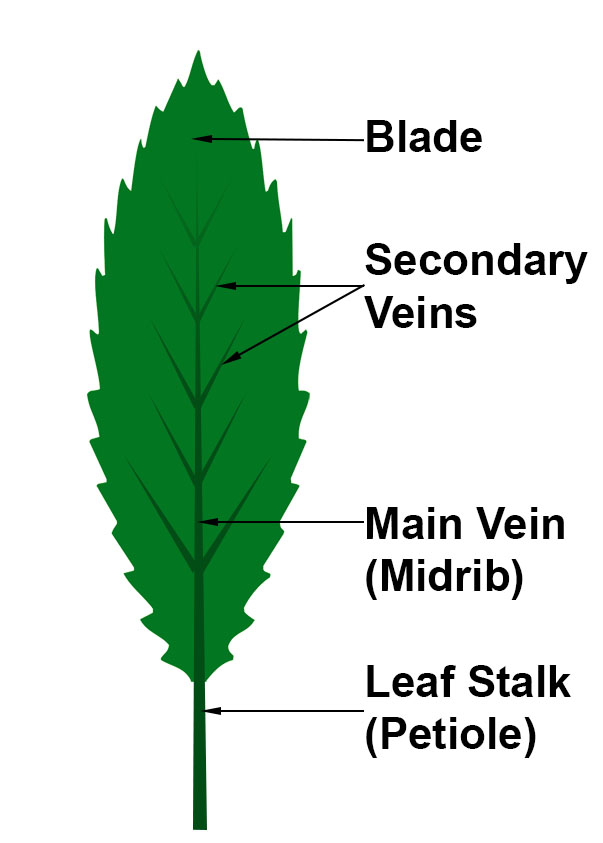 Vein: A vessel that conducts nutrients, sugars, and other substances throughout plant tissues; usually associated with leaves. The arrangement of veins in a leaf is called the venation pattern., similar to that of the Pink Lady's Slipper. Clintonia leaves, however, lack the deep parallel veins of Pink Lady's Slipper leaves.
Vein: A vessel that conducts nutrients, sugars, and other substances throughout plant tissues; usually associated with leaves. The arrangement of veins in a leaf is called the venation pattern., similar to that of the Pink Lady's Slipper. Clintonia leaves, however, lack the deep parallel veins of Pink Lady's Slipper leaves.
In late spring, the plant produces 3-6 pale yellow, drooping, bell-like flowers. Each flower is about 3/4" wide, with petal-like sepals.gif) Sepals: The parts that look like little green leaves and cover the outside of a flower bud to protect the flower before it opens. and six stamens
Sepals: The parts that look like little green leaves and cover the outside of a flower bud to protect the flower before it opens. and six stamens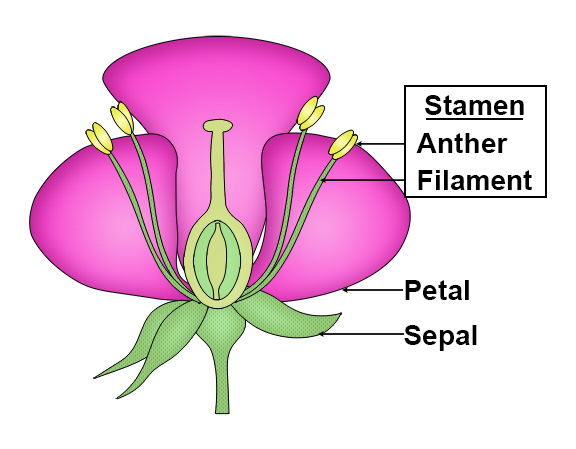 Stamen: The male part of the flower, made up of the filament and anther.. A tally of flowering dates for the upland Adirondack areas compiled by Michael Kudish, based on data collected from the early seventies to the early nineties, lists the earliest flower date as 25 May and the median date as 5 June. Recent observations on iNaturalist suggest a similar pattern.
Stamen: The male part of the flower, made up of the filament and anther.. A tally of flowering dates for the upland Adirondack areas compiled by Michael Kudish, based on data collected from the early seventies to the early nineties, lists the earliest flower date as 25 May and the median date as 5 June. Recent observations on iNaturalist suggest a similar pattern.
In midsummer, after the plant blooms, it produces fruit in the form of berries that transition from green to white, and ultimately to a deep porcelain blue. The berries are about a quarter inch wide. Standing on stalks ranging from 4 to sometimes 16 inches in height, the berries stand out in sharp contrast to the greens and browns of the forest floor. In the Adirondacks, the fruit usually appears in late July or August. The fruit is beautiful, but is said to be somewhat poisonous.
Uses of Clintonia
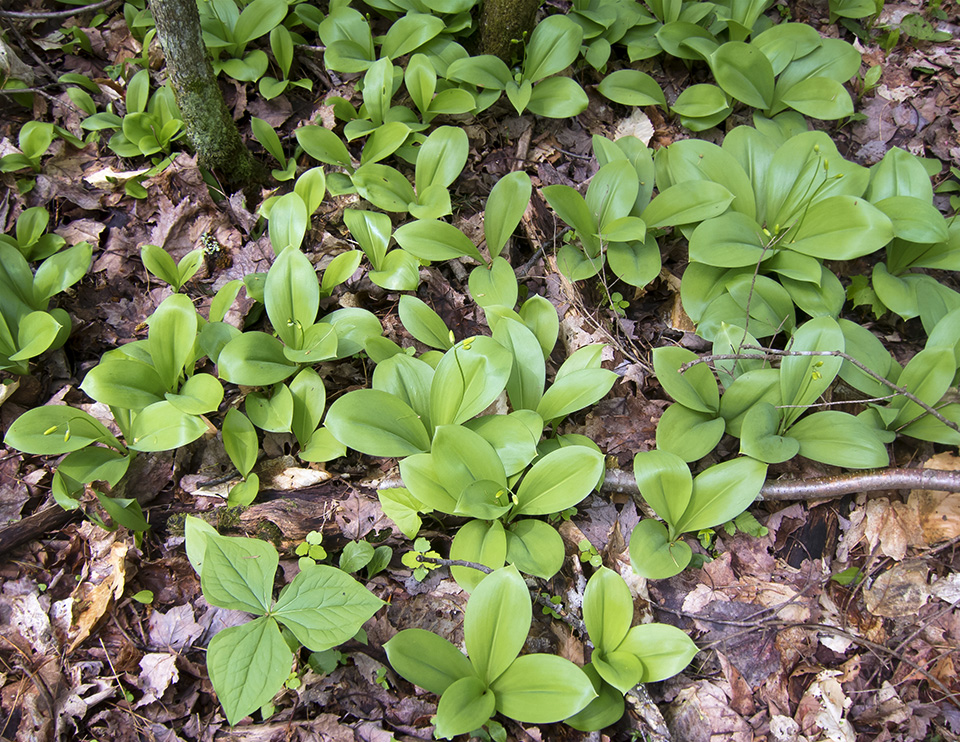
Clintonia has very limited edible uses. The young leaves, raw or cooked, are said to be edible, if harvested in the spring before they fully unfurl. They reportedly have a slightly sweetish cucumber flavor.
This species has limited use as a medicinal plant. Native Americans made some use of it, mainly for skin problems. For instance, the Algonquin applied a poultice of fresh leaves to open wounds, infections, and ulcers. The Chippewa used a poultice of fresh leaves for burns. The Iroquois used a decoction of the plant as a heart medication.
Wildlife Value of Clintonia
Clintonia has negligible wildlife value. One source indicates that chipmunks and birds consume the berries.
Distribution of Clintonia
Clintonia occurs in the northeastern part of the US and the eastern provinces of southern Canada. It ranges from Manitoba east to Newfoundland, south to North Carolina and Tennessee, and northwest to Illinois and Minnesota. This plant is considered endangered in Indiana and Ohio, threatened in Ohio, and a plant of special concern in Tennessee.
Clintonia can be found in most New York counties in the eastern half of the state. It occurs in all counties within the Adirondack Park Blue Line.
Habitat of Clintonia
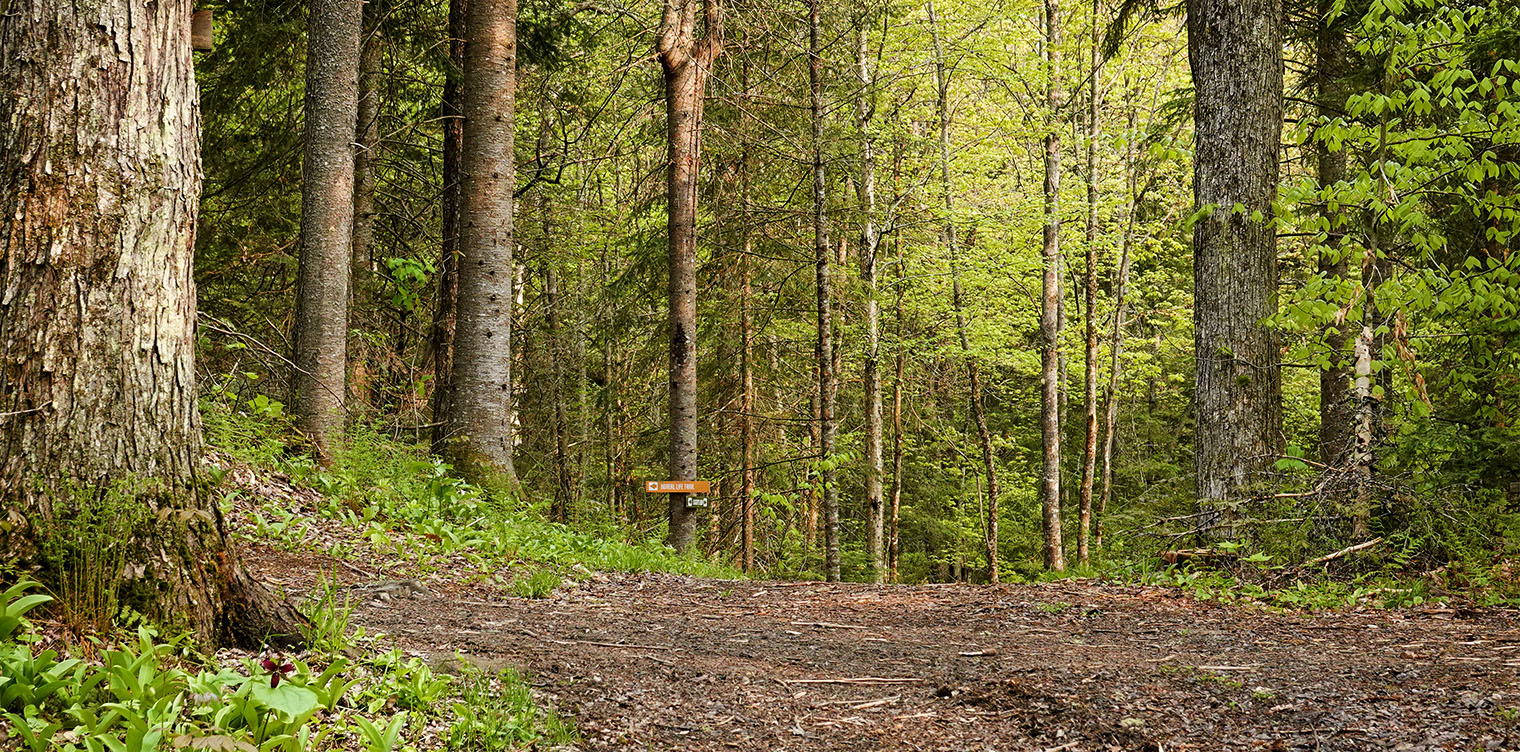
Clintonia can grow in well-drained to imperfectly drained soils. It is usually characterized as shade tolerant, but has been seen growing in full sun in some sites in the Adirondacks.
Clintonia's rather flexible soil and site requirements means that it can be found in a wide variety of habitats, including conifer, mixed wood, and hardwood forests. It can grow in a variety of shaded habitats, including dry to moist woods of all types, bogs, swamps, and rocky slopes.
In the Adirondacks, Clintonia is found in a wide variety of ecological communities, including:
Clintonia can be found along some portions of virtually all trails covered here. Look for it growing with Indian Cucumber-root, Purple Trillium, Hobblebush, and Striped Maple.
References
Michael Kudish. Adirondack Upland Flora: An Ecological Perspective (The Chauncy Press, 1992), pp. 23-28, 229.
New York Flora Association. New York Flora Atlas. Blue Bead-lily. Clintonia borealis (Aiton) Raf. Retrieved 12 April 2025.
United States Department of Agriculture. The Plants Database. Clintonia borealis (Aiton) Raf. Retrieved 12 April 2025.
USDA Forest Service. Plant of the Week. Bluebead Lily. Retrieved 12 April 2025.
Flora of North America. Clintonia borealis (Aiton) Rafinesque. Retrieved 12 April 2025.
Native Plant Trust. Go Botany. Yellow Blue-bead Lily. Clintonia borealis. Retrieved 12 April 2025.
New York State. Department of Environmental Conservation. New York Natural Heritage Program. Ecological Communities of New York State. Second Edition (March 2014), pp. 74-75, 92-92, 104-105, 121-122, 122-123, 123, 123-124, 124. Retrieved 12 April 2025.
New York Natural Heritage Program. 2025. Online Conservation Guide for Alpine Krummholz. Retrieved 12 April 2025.
New York Natural Heritage Program. 2025. Online Conservation Guide for Balsam Flats. Retrieved 12 April 2025.
New York Natural Heritage Program. 2025. Online Conservation Guide for Mountain Fir Forest. Retrieved 12 April 2025.
New York Natural Heritage Program. 2025. Online Conservation Guide for Mountain Spruce-Fir Forest. Retrieved 12 April 2025.
New York Natural Heritage Program. 2025. Online Conservation Guide for Northern White Cedar Swamp. Retrieved 12 April 2025.
New York Natural Heritage Program. 2025. Online Conservation Guide for Open Alpine Community. Retrieved 12 April 2025..
New York Natural Heritage Program. 2025. Online Conservation Guide for Pine-Northern Hardwood Forest. Retrieved 12 April 2025.
New York Natural Heritage Program. 2025. Online Conservation Guide for Spruce Flats. Retrieved 12 April 2025.
New York Natural Heritage Program. 2025. Online Conservation Guide for Spruce-Northern Hardwood Forest. Retrieved 12 April 2025.
New York State. Adirondack Park Agency. Preliminary List of Species Native Within the Adirondack Park Listed Alphabetically by Scientific Name and Sorted by Habit. Volume 1. Updated 10.23.2006, p.18. Retrieved 12 April 2025.
iNaturalist. Adirondack Park Observations. Bluebead Lily. Clintonia borealis. Retrieved 12 April 2025.
Lady Bird Johnson Wildflower Center. Clintonia borealis. Retrieved 12 April 2025.
National Audubon Society. Field Guide to North American Wildflowers. Eastern Region (Alfred A. Knopf, 2001), pp. 601-602. Retrieved 12 April 2025.
Mark J. Twery, et al. Changes in Abundance of Vascular Plants under Varying Silvicultural Systems at the Forest Ecosystem Research and Demonstration Area, Paul Smiths, New York. USDA Forest Service. Research Note NRS-169, p. 7. Retrieved 12 April 2025.
Plants for a Future. Clintonia borealis - (Aiton.) Raf. Retrieved 12 April 2025.
Lee Allen Peterson. A Field Guide to Edible Wild Plants. Eastern and Central North America (Houghton Mifflin Company, 1977), p. 140. Retrieved 12 April 2025.
University of Michigan. Native American Ethnobotany. A Database of Foods, Drugs, Dyes and Fibers of Native American Peoples, Derived from Plants. Clintonia borealis (Ait.) Raf. Yellow Bluebeadlily. Retrieved 12 April 2025.
Charles H. Peck. Plants of North Elba. (Bulletin of the New York State Museum, Volume 6, Number 28, June 1899). Retrieved 12 April 2025.
Anne McGrath. Wildflowers of the Adirondacks (EarthWords, 2000), p. 79. Retrieved 12 April 2025.
Doug Ladd. North Woods Wildflowers (Falcon Publishing, 2001), p. 124.
William K. Chapman, et al. Wildflowers of New York in Color (Syracuse University Press, 1998), pp. 90-91.
Lawrence Newcomb. Newcomb's Wildflower Guide (Little Brown and Company, 1977), pp. 338-339.
